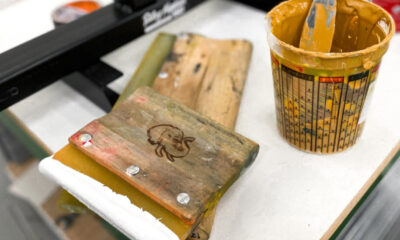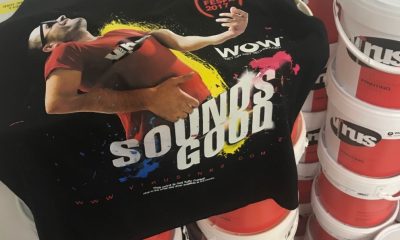Inks & Coatings
Published
11 years agoon

For years, ink-management systems have been available to printers in the form of solutions for ink mixing. Most print shops evaluating these systems are looking for help with color matching in production. While color matching is a very important aspect of these systems, the incredible control and cost savings that an ink-management system brings to overall print-shop operations are actually the most valuable benefits.
For years, ink-management systems have been available to printers in the form of solutions for ink mixing. Most print shops evaluating these systems are looking for help with color matching in production. While color matching is a very important aspect of these systems, the incredible control and cost savings that an ink-management system brings to overall print-shop operations are actually the most valuable benefits.
When is the best time to invest in a mixing system? Incorporating this technology makes sense for shop owners faced with any of the following scenarios:
• The shop can no longer rely on pre-mix colors to satisfy all of the print jobs.
• The ink technician has trouble hitting target colors by mixing standard, pre-mix colors.
• The pre-mix colors are getting too expensive to re-order.
• It’s difficult to manage ink inventory.
• The shop needs to know the real ink usage and costs of the individual print jobs.
Color correct
Mixing systems (Figure 1) provide more accurate color compared to mixing and matching standard inks because the mixing-system components are created with single pigments. Standard pre-mixed colors, on the other hand, consist of multiple pigments in each color.
When a shop mixes color using standard inks, the final mix is multi-pigmented, causing color shifts and subtle differences that make it difficult to repeat when needed (Figure 2). For example, creating a green in a mixing system with a yellow and blue will generate a consistent and bright green. However, with off-the-shelf colors, the yellow may have some red pigment in it. When mixed with a royal blue (also containing red pigment), the result will be a very dull green.
A mixing system provides color accuracy because the components are always the same and it is easy, mathematically, to predict the outcome. This alone saves on labor cost, time loss, and ink waste.
In addition to these benefits, the overall component costs of mixing systems make it possible to make custom colors and reduce costs. For instance, a pigment and base system will create a color utilizing small portions of the premium component (pigment concentrate) and larger amounts of the value component (base) (Figures 3A and 3B). The shop can therefore create a standard ink for a fraction of the cost compared to buying the finished color direct from an ink manufacturer.
Also, producing colors in house means that color is available faster. Instead of waiting for the delivery truck to arrive with a special color, the mixing system enables the ink tech to mix the color quickly while controlling the quantity, mixing what is needed for the job so there is no over-buying. In essence, the shop becomes its own ink manufacturer.
Control cost and inventory with software
Most color systems also offer supporting ink-mixing software. This software generally offers a variety of ways to save time and money.
Formula database Mixing software allows the technician to quickly search the database for the formula needed via a look-up filter. This feature will comb through the formula listings, saving time and labor for ink technicians searching for a color.
Custom formulas Generally, the software will also allow the technician to adjust calculations. This feature will help an ink tech create new color on the fly and rename to save as a custom color.
Adaptability Most ink-mixing software has a re-calculation feature that helps a technician who may have accidently added too much of a component. This feature will recalculate the amount for the remaining components to be added, putting the formula back on track and reducing waste.
Cost control Tracking the costs of the ink components is another important value feature commonly offered. By custom loading the component costs into the software, the ink tech is able to report actual ink costs per gallon or per job. This feature makes it easier to figure and track costs, thus guiding pricing on individual jobs.
Inventory control Most software can also streamline inventory control by estimating ink usage in relation to overall print quantity. This feature allows the user to keep up with the individual component usage on an ink per print scale, resulting in less waste, reduced inventory and eliminating over-purchasing.
Reduce waste One of the most valuable tools with mixing-system software is the recycle feature. This enables users to take unused ink and use it as a component to produce a new color. This recycling feature saves money by keeping inventory low, significantly reducing waste and minimizing component purchases (Figure 4).
Which system?
Now that we have established the general cost savings associated with a mixing system, it’s time to look at the different types of systems that are available to evaluate which is the best fit for your shop. There are three basic types of mixing systems that dominate the current plastisol market: pigment concentrates (PCs), finished ink, and colorant (or hybrid).
A PC system uses pigment concentrates and base to create color. This same system is used by ink manufacturers to create colors in production. The PC/base system was the first type of ink-mixing system technology introduced to the garment screen-printing market and offers maximum versatility. The system commonly includes 15-18 pigment concentrates and a large range of bases designed for printing onto various materials. The PC system offers the most flexibility and control, producing clean color formulas for use with multiple bases, including special-effect bases (Figure 5). The initial component conversion requires a greater investment than the other systems, but the overall value—or return on investment—is much more significant, as it greatly reduces long-term ink costs.
A finished-ink system uses mixing components that are fully fusible (curable). These components can be used alone or can be mixed together to hit color. Because of its ease of use and lower initial setup costs, it is the most commonly used mixing system. Generally, this system includes 15 single-pigment inks for mixing colors. Though this system isn’t as versatile as the other two, the finished-ink system utilizes simple formulas that are always safe and easy to follow.
A colorant system utilizes fusible color concentrates and base to create custom colors. The balanced (or hybrid) colorant system offers the freedom of using a variety of bases (like that of the PC system) with the safety of balanced, fusible colors (like that of the finished-ink system). This system generally includes 15 colorants and a variety of bases for printing onto a range of substrates. The colorants create clean formulas that can also be used with specialty and texture bases. One unique feature of this hybrid technology is the ability to add as much colorant component as needed to achieve the desired color or opacity. For instance, by including roughly 10% additional pigment in a formula, the color will go from translucent to super opaque.
Deciding to implement a color mixing system may seem like a large transition and initial expense, but the return on investment is well worth it. Once a shop gets in the routine of using the mixing system technology and capabilities, the cost savings on labor, waste, and purchasing are nearly immediate, offering immense value to all facets of production.
Ray Smith is senior print-application specialist, PolyOne Wilflex Inks, www.polyone.com.

Subscribe

Magazine
Get the most important news
and business ideas from Screenprinting Magazine.
Most Popular
-

 Art, Ad, or Alchemy1 month ago
Art, Ad, or Alchemy1 month agoF&I Printing Is Everywhere!
-

 Case Studies1 month ago
Case Studies1 month agoHigh-Density Inks Help Specialty Printing Take Center Stage
-

 Andy MacDougall1 month ago
Andy MacDougall1 month agoFunctional and Industrial Printing is EVERYWHERE!
-

 Columns2 weeks ago
Columns2 weeks ago8 Marketing Mistakes Not to Make When Promoting Your Screen Printing Services Online
-

 Editor's Note2 weeks ago
Editor's Note2 weeks agoLivin’ the High Life
-

 Thomas Trimingham2 months ago
Thomas Trimingham2 months ago“Magic” Marketing for Screen Printing Shops
-

 Marshall Atkinson2 weeks ago
Marshall Atkinson2 weeks agoHow to Create a Winning Culture in Your Screen-Printing Business
-

 News & Trends1 month ago
News & Trends1 month agoWhat Are ZALPHAS and How Can You Serve Them in Your Print Business?





